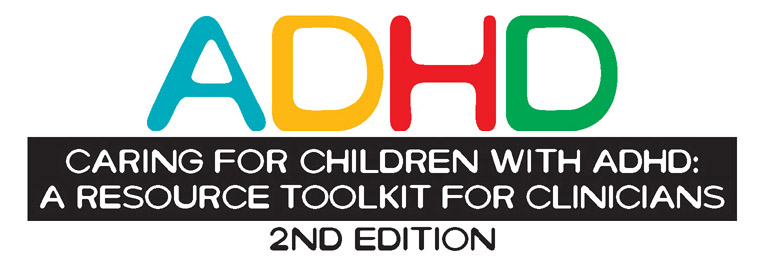ADHD Toolkit
Caring for Children With ADHD: A Resource Toolkit for Clinicians

Introduction
This toolkit provides access to the American Academy of Pediatrics (AAP) “ADHD: Clinical Practice Guideline for the Diagnosis, Evaluation, and Treatment of the Child and Adolescent With Attention-Deficit/ Hyperactivity Disorder” as well as an interactive ADHD care process algorithm.
Initial Assessment and Diagnosis
Initial Assessment and Diagnosis provides resources and tools to aid clinicians in the early assessment of ADHD in children aged 4 to 18 years as well provides specific screening tests to aid clinicians in identifying comorbid conditions and educational materials for parents to better understand the diagnosing of common comorbid conditions.
Treatment and Medication
Treatment and Medication provides resources and tools for clinicians and parents addressing treatment and medication.
Monitoring and Follow-Up
Monitoring and Follow-up provides clinicians with decision-support materials for medications and parents with tools to support appropriate medication use.
Additional Parent Tools
Additional Parent Tools contains parent empowerment tools to better understand ADHD.
Health Care Financing
Health Care Financing provides information on how to code appropriately for ADHD.
Additional Physician Resources
Additional Physician Resources with active links to applicable internet sites on ADHD.
Louisiana Developmental Screening Resources
ADHD Resource Toolkit
Quick Links
NICHQ Vanderbilt Scales
Clinician Tools
- PHQ 9
- CRAFFT | SPANISH
- Scared Child
- Guidance for Primary Care Clinicians – Managing Common Mental Health Symptoms in Children and Adolescents: Background
- Recommendations for Cardiovascular Evaluation and Monitoring of Children and Adolescents Receiving Medication for ADHA
- ADHD Medication Management Plan | SPANISH
- ADHD Medication Guide
- What Every Pediatrician Needs to Know About ADHD and School
- Working with Families Interested in Complementary and Alternative Medicine for ADHD
- Behavior Modification Treatment for Children with ADHD
- Basic Facts: What Every Clinician Should Know Before Starting a Patient on Medication
- Medication Titration Monitoring Tool
- ADHD Coding Fact Sheet for Primary Care Pediatricians
- ADHD Internet Resources | SPANISH
Parent Tools
- ADHD and Coexisting Disorders (Overview) | SPANISH
- ADHD and Depression | SPANISH
- ADHD and Disruptive Behavior Disorders | SPANISH
- ADHD and Sleep Disorders| SPANISH
- ADHD and Tics and Tourette Syndrome | SPANISH
- Managing Medicine for Children and Teenagers with AD/HD | SPANISH
- Homework Tips for Parents | SPANISH
- Basic Facts: What Every Parent Should Know Before Starting a Child on Medication | SPANISH
- The Use and Abuse of Phychostimulant Medication: Tips for Parents and Teens | SPANISH
- ADHD Parents Medication Guide | SPANISH
- Why is My Child Having Trouble in School? | SPANISH
- Why An I Having So Much Trouble With School? | SPANISH
- A Message to Parents of Teen Drivers | SPANISH
- Parent-Teen Driving Agreement | SPANISH
Introduction
Introduction to Caring for Children With ADHD: A Resource Toolkit for Clinicians, 2nd Edition
 Pediatric Primary Care Clinicians Play an Important Role in the Care of Children and Youth With Attention/Deficit-Hyperactivity Disorder Attention-deficit/hyperactivity disorder (ADHD) is the most common neurobehavioral disorder of childhood and can profoundly affect the academic achievement, well-being, and social interactions of children.1 The American Academy of Pediatrics (AAP) recently revised its previous guidelines for diagnosis, evaluation, and treatment of ADHD.2,3 The high prevalence rate of ADHD makes it impossible for many children to receive care from mental health clinicians. Pediatric primary care clinicians have unique access to children and families and thus are uniquely situated to diagnose and treat children with this condition. In addition to providing their own guidance, primary care clinicians play an important role in advocating for and linking families to resources and school programs, all of which may positively influence the social-emotional health of children.
Pediatric Primary Care Clinicians Play an Important Role in the Care of Children and Youth With Attention/Deficit-Hyperactivity Disorder Attention-deficit/hyperactivity disorder (ADHD) is the most common neurobehavioral disorder of childhood and can profoundly affect the academic achievement, well-being, and social interactions of children.1 The American Academy of Pediatrics (AAP) recently revised its previous guidelines for diagnosis, evaluation, and treatment of ADHD.2,3 The high prevalence rate of ADHD makes it impossible for many children to receive care from mental health clinicians. Pediatric primary care clinicians have unique access to children and families and thus are uniquely situated to diagnose and treat children with this condition. In addition to providing their own guidance, primary care clinicians play an important role in advocating for and linking families to resources and school programs, all of which may positively influence the social-emotional health of children.
- A longitudinal, trusting, and empowering therapeutic relationship with children and family members
- The family-centeredness of the medical home5–12
- Unique opportunities to promote healthy lifestyles, reinforce strengths in children and families, recognize adverse childhood experiences and stressors associated with social-emotional problems, and offer anticipatory guidance13–15
- Understanding of common social, emotional, and educational problems in the context of a child’s development and environment13
- Experience working with specialists in the care of children with special health care needs and serving as coordinators and case managers through the medical home
- Familiarity with chronic care principles and practice improvement methods
Yet primary care clinicians experience many barriers to providing services for children with ADHD, including discomfort with their knowledge and skills, time constraints, poor payment, limited access to mental health consultation and referral resources, and administrative issues with insurance plans.16,17 Also concerning is the compelling perspective of parents of children with mental health concerns.
Caring for Children With ADHD: A Resource Toolkit for Clinicians, 2nd Edition, is designed to provide tools and materials to implement and document the procedures as outlined in the “Overview of the ADHD Care Process” algorithm that complements the revised guideline recommendations.18 The number of diagnostic assessment tools in the kit has expanded, particularly those to help clinicians better evaluate possible comorbid conditions. There are also materials to cover a broader age range, such as a behavioral contract that families can use with their teenagers. Decision support materials that clinicians can use with families have been updated and expanded. With the guideline revisions, development of a more detailed practice algorithm, expanded number of tools, and AAP Quality Improvement Innovation Network members using these tools in practice to test for feasibility, we have enhanced the ability of primary care clinicians to provide exemplary services to patients with ADHD and their families.
References
2. American Academy of Pediatrics Committee on Quality Improvement, Subcommittee on Attention-Deficit/Hyperactivity Disorder. Clinical practice guideline: diagnosis and evaluation of the child with attention-deficit/hyperactivity disorder. Pediatrics.2000;105(5):1158–1170
3. American Academy of Pediatrics Subcommittee on Attention-Deficit/Hyperactivity Disorder, Committee on Quality Improvement. Clinical practice guideline: treatment of the school-aged child with attention-deficit/hyperactivity disorder. Pediatrics.2001;108(4):1033–1044
4. Harris M. Rural private pediatric practice ownership and management of a mental health practice [teleconference audio file]. Elk Grove Village, IL: American Academy of Pediatrics; October 25, 2006
5. American Academy of Pediatrics. Family pediatrics: report of the Task Force on the Family. Pediatrics. 2003;111(Suppl 2):1541–1571
6. Wertlieb D. Converging trends in family research and pediatrics: recent findings for the American Academy of Pediatrics Task Force on the Family. Pediatrics. 2003;111(Suppl 2):1572–1587
7. Blanchard LT, Gurka MJ, Blackman JA. Emotional, developmental, and behavioral health of American children and their families: a report from the 2003 National Survey of Children’s Health. Pediatrics. 2006;117(6):e1202–e1212
8. Kim HK, Viner-Brown SI, Garcia J. Children’s mental health and family functioning in Rhode Island. Pediatrics. 2007;119(Suppl):S22–S28
9. Beardslee WR, Gladstone TRG, Wright EJ, Cooper AB. A family-based approach to the prevention of depressive symptoms in children at risk: evidence of parental and child change. Pediatrics. 2003;112(2):e119–e131
10. Allmond BW, Tanner JL, Gofman HF. The Family Is the Patient: Using Family Interviews in Children’s Medical Care. 2nd ed. Baltimore, MD: Lippincott Williams & Wilkins; 1999
11. Coleman WL, Howard BJ. Family-focused behavioral pediatrics: clinical techniques for primary care. Pediatr Rev. 1995;16(12):448–455
12. Coleman WL. Family-focused pediatrics: solution-oriented techniques for behavioral problems. Contemp Pediatr. 1997;14(7):121–134
13. Hagan JF, Shaw JS, Duncan PM, eds. Bright Futures: Guidelines for Health Supervision of Infants, Children, and Adolescents. 3rd ed. Elk Grove Village, IL: American Academy of Pediatrics; 2008
14. Garg A, Butz AM, Dworkin PH, Lewis RA, Thompson RE, Serwint JR. Improving the management of family psychosocial problems at low-income children’s well-child care visits: the WE CARE Project. Pediatrics. 2007;120(3):547–558
15. Ginsburg KR, American Academy of Pediatrics Committee on Communications and Committee on Psychosocial Aspects of Child and Family Health. The importance of play in promoting healthy child development and maintaining strong parent-child bonds. Pediatrics. 2007;119(1):182–191
16. Horwitz SM, Kelleher KJ, Stein REK, et al. Barriers to the identification and management of psychosocial issues in children and maternal depression. Pediatrics. 2007;119(1):e208–e218
17. American Academy of Child and Adolescent Psychiatry Committee on Health Care Access and Economics, American Academy of Pediatrics Task Force on Mental Health. Improving mental health services in primary care: reducing administrative and financial barriers to access and collaboration. Pediatrics. 2009;123(4):1248–1251
18. American Academy of Pediatrics Steering Committee on Quality Improvement and Management, Subcommittee on Attention-Deficit Hyperactivity Disorder. ADHD: clinical practice guideline for the diagnosis, evaluation, and treatment of attention-deficit/hyperactivity disorder in children and adolescents. Pediatrics. In press
ADHD: Clinical Practice Guideline
ADHD Care Process Overview
Implementing the Key Action Statements
Assessment & Diagnosis
Initial Assessment and Diagnosis
 An effective treatment begins with an accurate, well-established diagnosis.
An effective treatment begins with an accurate, well-established diagnosis.
The American Academy of Pediatrics (AAP) clinical practice guideline, “ADHD: Clinical Practice Guideline for the Diagnosis, Evaluation, and Treatment of Attention-Deficit/Hyperactivity Disorder in Children and Adolescents,” contains the following action statements for diagnosis of attention-deficit/hyperactivity disorder (ADHD):
- The primary care clinician should initiate an evaluation for ADHD for any child 4 through 18 years of age who presents with academic or behavioral problems and symptoms of inattention, hyperactivity, or impulsivity (quality of evidence B/strong recommendation).
- To make a diagnosis of ADHD, the primary care clinician should determine that Diagnostic and Statistical Manual of Mental Disorders, Fourth Edition (DSM-IV-TR) criteria have been met (including documentation of impairment in more than 1 major setting), and information should be obtained primarily from reports of parents or guardians, teachers, and other school and mental health clinicians involved in the child’s care. The primary care clinician should also rule out any alternative cause (quality of evidence B/strong recommendation).
This clinical practice guideline is not intended as the sole source in the evaluation of children with ADHD. Rather, it is designed to assist primary care clinicians by providing a framework for diagnostic decision-making. It is not intended to replace clinical judgment or to establish a protocol for all children with the condition.
NICHQ Vanderbilt ADHD Primary Care Initial Evaluation Form
Intended for use by the clinician, this tool helps organize the various pieces of information needed to make a diagnosis of ADHD—patient history of presenting symptoms; relevant past and family medical history; a pertinent review of systems to consider other conditions that can look like or coexist with ADHD; physical examination, including vision, hearing, and neurologic; and a review of validated assessment scales, including a comorbidity screen. This form also can serve to organize the child’s treatment plan, including making appropriate referrals, identifying target symptoms, and scheduling appropriate follow-up and parent education.
NICHQ Vanderbilt Assessment Scale: Parent Informant English | Spanish
This tool is a validated, parent-completed questionnaire that obtains information needed for diagnosis from a parent about core symptoms of ADHD and areas of functional impairment. It includes a screen for comorbidities including externalizing disorders (oppositional-defiant and conduct) and internalizing disorders (depressive and anxiety).
Sample Scored NICHQ Vanderbilt Assessment Scale: Parent Informant English | Spanish
This tool, intended for the clinician and parent, illustrates how the scale is completed and scored.
NICHQ Vanderbilt Assessment Scale: Teacher Informant
This tool is a teacher-completed, validated questionnaire that obtains information needed for diagnosis from a teacher about core symptoms of ADHD and areas of functional impairment. It includes a screen for comorbidities including externalizing disorders (oppositional-defiant and conduct) and internalizing disorders (depressive and anxiety). The review of functional impairments can be used to help identify children who require additional screening for learning disabilities.
Scoring Instructions for NICHQ Vanderbilt Assessment Scales
This tool reviews for the clinician how to score and interpret the NICHQ Vanderbilt parent and teacher assessment and follow-up scales.
Sample Cover Letter to Teachers From Clinicians PDF | Word
Intended for use by the clinician, this letter serves as an introduction that may accompany the assessment scale requested from a teacher. It is suggested that a Release of Information Form, signed by the parent, accompany the letter. This sample is provided as a template; clinicians can adapt it to fit their own practice approach.
Assessment and Diagnosis With Comorbidities
The AAP clinical practice guideline, “ADHD: Clinical Practice Guideline for the Diagnosis, Evaluation, and Treatment of Attention-Deficit/Hyperactivity Disorder in Children and Adolescents,” contains the following action statement addressing comorbidities:
- In the evaluation of a child for ADHD, the primary care clinician should include assessment for other conditions that might coexist with ADHD, including emotional or behavioral (eg, anxiety, depressive, oppositional defiant, and conduct disorders), developmental (eg, learning and language disorders or other neurodevelopmental disorders), and physical (eg, tics, sleep apnea) conditions (quality of evidence B/strong recommendation).
Clinician Tool for Screening
Pediatric Symptom Checklist-17 English | Spanish | Scoring Instructions
A parent-completed questionnaire that screens children for behavioral disorders, this tool has internalizing, externalizing, and attention subscales. The screening may be used as part of an annual evaluation of children with ADHD to identify those who may have significant comorbidity. The screen and its attention subscale can also be used to identify children from the general population for further evaluation of possible ADHD.
Clinician Tools for Further Evaluation
PHQ-9 English | Scoring and Instructions
Depression can complicate ADHD or present with similar symptoms. The PHQ-9 is a patient-completed questionnaire that screens for depressive disorders. It can be used to identify or follow patients with comorbid depressive disorders.
CRAFFT Provider Guide
This guide outlines a clinician approach to evaluating and treating adolescents for substance abuse concerns.
The CRAFFT Screening Questionnaire | Las Preguntas CARLOS (CRAFFT)
Substance abuse can complicate ADHD or present with similar symptoms. CRAFFT can be given as a written questionnaire or asked of patients to screen for substance abuse disorders.
Screen for Child Anxiety Related Disorders (SCARED) Child Version
Anxiety disorders can present with inattention and can also be comorbid with ADHD. This questionnaire can be used to identify patients who require further evaluation or treatment for anxiety disorders.
Guidance for Primary Care Clinicians: Managing Common Mental Health Symptoms in Children and Adolescents: Background
This tool from the AAP Addressing Mental Health Concerns in Primary Care: A Clinician’s Toolkit provides information on a general approach to addressing mental health symptoms in a primary care setting. It includes suggestions on building a therapeutic alliance, and the role of primary care clinicians in the evaluation of children younger than 5 years and in the treatment of children who present with more severe problems.
Recommendations for Cardiovascular Evaluation and Monitoring of Children and Adolescents Receiving Medications for ADHD
This tool reviews recommendations for cardiovascular screening and monitoring during medication treatment of ADHD. These recommendations are based on a joint statement by the AAP and American Heart Association (AHA) following the AHA scientific statement of April 21, 2008.
Parent Tools
The following parent-directed handouts from Children and Adults with Attention Deficit/Hyperactivity Disorder (CHADD) discuss approach to treatment of ADHD and other comorbidities:
ADHD and Coexisting Disorders (Overview) English | Spanish
ADHD and Depression English | Spanish
ADHD and Disruptive Behavior Disorders English | Spanish
ADHD and Sleep Disorders English | Spanish
ADHD and Tics and Tourette Syndrome English | Spanish
Treatment & Medication
Multimodal Approach
 A treatment plan is tailored to the individual needs of the child and family. It may require medical, educational, behavioral, and psychological interventions. This multimodal approach can improve the child’s behavior in the home, classroom, and social settings. In most cases, successful treatment will include a combination of stimulant medication and behavior therapy.
A treatment plan is tailored to the individual needs of the child and family. It may require medical, educational, behavioral, and psychological interventions. This multimodal approach can improve the child’s behavior in the home, classroom, and social settings. In most cases, successful treatment will include a combination of stimulant medication and behavior therapy.
The American Academy of Pediatrics clinical practice guideline, “ADHD: Clinical Practice Guideline for the Diagnosis, Evaluation, and Treatment of Attention-Deficit/Hyperactivity Disorder in Children and Adolescents,” contains the following key action statements for treatment of attention-deficit/hyperactivity disorder (ADHD) in children aged 4 to 18 years:
- Recommendations for treatment of children and youth with ADHD vary depending on the patient’s age.
- For preschool-aged children (4–5 years of age), the primary care clinician should prescribe evidence-based parent- and/or teacher-administered behavior therapy as the first line of treatment (quality of evidence A/strong recommendation) and may prescribe methylphenidate if the behavior interventions do not provide significant improvement and there is moderate-to-severe continuing disturbance in the child’s function. In areas in which evidence-based behavioral treatments are not available, the clinician needs to weigh the risks of starting medication at an early age against the harm of delaying diagnosis and treatment (quality of evidence B/recommendation).
- For elementary school-aged children (6–11 years of age), the primary care clinician should prescribe FDA-approved medications for ADHD (quality of evidence A/strong recommendation) and/or evidence-based parent- and/or teacher-administered behavior therapy as treatment for ADHD, preferably both (quality of evidence B/strong recommendation). The evidence is particularly strong for stimulant medications and sufficient but less strong for atomoxetine, extended-release guanfacine, and extended-release clonidine (in that order) (quality of evidence A/strong recommendation). The school environment, program, or placement is a part of any treatment plan.
- For adolescents (12–18 years of age), the primary care clinician should prescribe FDA-approved medications for ADHD with the assent of the adolescent (quality of evidence A/strong recommendation) and may prescribe behavior therapy as treatment for ADHD (quality of evidence C/recommendation), preferably both.
- Primary care clinicians should titrate doses of medication for ADHD to achieve maximum benefit with minimum adverse effects (quality of evidence B/strong recommendation).
Clinician Tools
ADHD Medication Management Plan (English) PDF | Word | (Spanish) PDF | Word
This document is intended to be filled out by the clinician and given to the parent to provide a written ADHD management plan. It includes prompts to identify target symptoms for improvement and explicit instructions on when medication is given, and also lists side effects that require immediate follow-up, instructions for further evaluation, and follow-up plans. This tool is provided as a template; clinicians can adapt it to meet their own practice needs.
ADHD Medication Guide
Produced by the North Shore-Long Island Jewish Health System, Inc., this guide is a visual aid for professionals caring for individuals with ADHD. It provides full-color, actual-size images of stimulant and non-stimulant medications indicated for the treatment of ADHD by the US Food and Drug Administration. In clinical practice, the guide may be used to assist patients in identifying medications previously tried and clinicians in identifying medication options for the future. The guide identifies all available dose formulations and indicates how each medication can be given and when a generic formulation is available.
What Every Pediatrician Needs to Know About ADHD and School
This tool summarizes the process of obtaining school evaluations and accommodations for children with ADHD. Eligibility requirements and typical accommodations for 504 plans and special education services are reviewed.
Working With Families Interested in Complementary and Alternative Medicine for ADHD
This tool outlines a general approach to working with families interested in treatment with complementary and alternative medicine (CAM). References are given for more detailed information about CAM and ADHD.
Behavior Modification Treatment for Children With ADHD
This tool explains the basic principles of behavior modification treatments for children with ADHD. Behavior modification is the best evidenced-based psychosocial treatment for ADHD.
Parent Tools
Managing Medicine for Children and Teenagers with AD/HD English | Spanish
This tool includes basic information about the diagnosis of ADHD and outlines the role of medication in ADHD treatment, different classes of medication used for ADHD treatment and possible side effects, and dose-adjustment process.
Homework Tips for Parents English | Spanish
Intended for parents to understand and assist their child in completing homework, this tool identifies common problems, outlines helpful solutions, and suggests when additional resources might be useful.
Monitoring & Follow-Up
 Careful follow-up is crucial to obtaining the best attention-deficit/hyperactivity disorder (ADHD) treatment outcomes. This section contains decision-support materials for clinicians to choose appropriate medications, titrate doses for optimal function, and identify medication side effects. Parent tools are included to support appropriate medication use.
Careful follow-up is crucial to obtaining the best attention-deficit/hyperactivity disorder (ADHD) treatment outcomes. This section contains decision-support materials for clinicians to choose appropriate medications, titrate doses for optimal function, and identify medication side effects. Parent tools are included to support appropriate medication use.
Clinician Tools
NICHQ Vanderbilt Assessment Follow-up: Parent Informant English | Spanish
This is a validated questionnaire for parents to fill out that organizes information needed to follow a child’s response to treatment. It asks parents about a child’s core symptoms of ADHD and functional status, as well as side effects of the most frequently used medication treatments.
NICHQ Vanderbilt Assessment Follow-up: Teacher Informant
This is a validated questionnaire for teachers to fill out that organizes information needed to follow a child’s response to treatment. It asks teachers about a child’s core symptoms of ADHD and functional status at school, as well as side effects of the most frequently used medication treatments.
This tool outlines factors a clinician should consider before initiating medication treatment, including setting treatment goals, criteria to use in selecting appropriate medication, and follow-up plans.
Medication Titration Monitoring Tool (Excel)
This Excel file can be used and modified by the clinician to follow the effectiveness and side effects of medication in a simple flow sheet.
Parent Tools
Basic Facts: What Every Parent Should Know Before Starting a Child on Medication English | Spanish
This tool explains important information for parents about medication treatment for ADHD, including the role of medication, side effects, dose titration, and follow-up.
The Use and Abuse of Psychostimulant Medication: Tips for Parents and Teens English | Spanish
Additional Parent Tools
 This section contains parent empowerment tools for understanding attention-deficit/hyperactivity disorder (ADHD) and supporting school performance. A tool specifically addressed to the adolescent about school difficulties is also included.
This section contains parent empowerment tools for understanding attention-deficit/hyperactivity disorder (ADHD) and supporting school performance. A tool specifically addressed to the adolescent about school difficulties is also included.
Teen drivers with ADHD are at increased risk for accidents; a parent tool is included to promote safe and responsible driving.
This guide offers a detailed review of diagnosis and treatment of ADHD, including information about selecting a medication, combined treatment, and managing medication side effects. English and Spanish versions can be accessed on the provided link.
This tool explains common problems children with ADHD have at school and suggests practical approaches to management.
Why Am I Having So Much Trouble With School? English | Spanish
Intended for the older child or teenager, this tool explains common difficulties children with ADHD have at school and suggests practical approaches to blank-management.
Parent-Teen Driving Agreement and A Message to Parents of Teen Drivers English | Spanish
Pediatrician Implementation Guide English | Spanish
Teen drivers with ADHD are at increased risk of crashes and citations when they begin to drive. The Parent-Teen Driving Agreement is intended to be completed through discussion between parents and their teens about appropriate rules and expectations for safe driving. A Message to Parents of Teen Drivers outlines how parents can set rules that decrease a child’s risk of crashes during the early driving years.
Health Care Financing

UPDATED- Jan. 2017- ADHD Coding Fact Sheet for Primary Care Pediatricians- ICD-10 Coding
ADHD Coding Fact Sheet for Primary Care Pediatricians
This tool contains detailed information about how to bill for attention-deficit/hyperactivity disorder (ADHD) care using evaluation and management codes and how to use modifier 25 to bill for ADHD care when it is offered as part of routine well-child care. A comprehensive listing of Current Procedural Terminology and International Classification of Diseases, Ninth Revision, Clinical Modification codes commonly reported by pediatric health care practitioners in providing ADHD-related services is also included.
Additional Physician Resources



